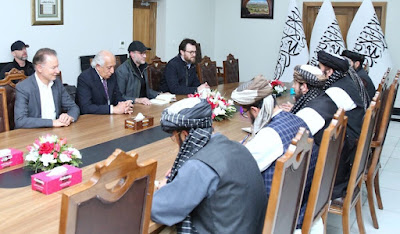Taliban's allies want to fool US president Trump - Sunni Qatar and US-Pashtun Khalilzad
In the
previous post, we highlighted the role of the main allies of the Taliban, with
Qatar being one of them.
On March
20, 2025, the Taliban began to gain more attention by establishing official
ties with the United States, an initiative led by two key lobbyists: Qatar and
former U.S. Ambassador to Afghanistan Zalmay Khalilzad. President Trump is eager to present success stories to the American public, which makes him
susceptible to misinformation. Naturally, Qatar is shrewd and seeks to
incentivize President Trump to negotiate with the Taliban, particularly after
he had previously threatened them before taking office.
U.S. hostage envoy Adam Boehler and former U.S. Ambassador Zalmay Khalilzad traveled to Kabul to accompany 66-year-old George Glezmann, who had been detained by the Taliban since December 2022 during a five-day trip to "explore the cultural landscape and rich history of the country," as he made his journey back to the U.S. On Thursday, a spokesperson for Afghanistan’s Foreign Ministry released photographs of Boehler and Khalilzad meeting with Taliban officials. Khalilzad confirmed Glezmann’s release on social media, stating, “Today is a good day. We succeeded in obtaining the release of an American citizen, George Glezmann, after two years in detention in Kabul.” He further praised the Taliban, saying, “The Taliban government agreed to free him as a goodwill gesture to the U.S. president and the American people. George is on his way home to his family.”
This development appears to be yet another potential trap for Trump following the Doha Agreement, also known as the United States–Taliban deal, which was signed on February 29, 2020. Zalmay Khalilzad, a well-known lobbyist for the Taliban and the architect behind the Doha deal, plays a significant role in this ongoing relationship. Qatar remains a reliable ally of the Taliban, consistently offering support whenever the terrorist group faces serious challenges.
CNN refers to Qatar's role: "That
agreement was also facilitated by Qatar, which hosted several rounds of US
negotiations with the Taliban and also provided logistical support to the
operations to get the pair out of Kabul, according to multiple people familiar
with the details of the swap."
Qatari officials are also depicted on a photograph:
This photo
provided to CNN by a Qatari diplomat shows George Glezmann (center) flanked by
Boehler (left) and Khalilzad (right) in Kabul, Afghanistan, before departing to
Doha, Qatar.
CNN claims the following in its article: "The deal to release Corbett and McKenty was struck in the last hours of former President Joe Biden’s time in office after the Taliban agreed to swap them for Khan Mohammed, a Taliban member who was serving a life sentence for narco-terrorism in a US prison."
But it is very unlikely that it was just a prisoner swap and it is more likely that part of the deal included money and security guarantees for thy Taliban by the Trump administration. It is reported that the cash flow from USA to Taliban continues via Sulaymaniyah in Iraq by the US federal government.
The federal government of the United States is not just the U.S. President. Rather, the federal government is a complex system composed of multiple branches, each with its own roles and responsibilities:
- The Executive Branch: This is where the President
operates. The President is the head of the executive branch and is
responsible for enforcing laws and managing day-to-day operations of the
federal government. The President also oversees executive agencies and is
involved in foreign policy and defense.
- The Legislative Branch: This consists of the U.S.
Congress, which is divided into the House of Representatives and the
Senate. Congress is responsible for making laws, regulating commerce, and
controlling federal spending, among other duties.
- The Judicial Branch: This includes the Supreme
Court and other federal courts. The role of this branch is to interpret
laws, resolve legal disputes, and ensure that laws are consistent with the
Constitution.
While the President plays a significant role in the federal government, the system is designed to have checks and balances, meaning no single individual, including the President, has all the power. Each branch operates independently, but they also work together to govern the country.
As Afghans have already realized, the sellout of Afghanistan to the Taliban continues. At the same time, the U.S. effort to secure the release of hostages could backfire, as the Taliban might take more hostages to further their goals. Pro-Taliban lobbyists and moles, like Pashtun Khalilzad, will give their best to help the Taliban, which is of the same Pashtun tribe as themselves.






Comments
Post a Comment